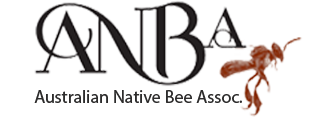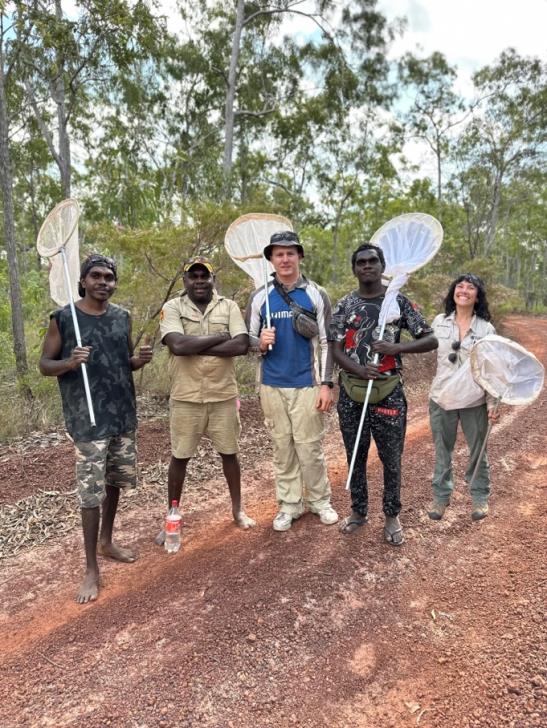Dr Rachele Wilson, Clancy Lester & Prof Margie Mayfield, University of Melbourne
Stingless bee honey, or ‘Guku’ is much more than a sweet treat to the Yolŋu First Nation of North East Arnhem Land, NT. Guku is an integral part of their dreamings, songlines and traditions, and has been for thousands of generations.
Each Yolŋu person is designated one of the two moieties at birth: Dhuwa and Yirritja. These two groups connect with the two stingless bee genera Austroplebeia spp. (Dhuwa) and Tetragonula spp. (Yirritja). Animal totems, marital systems, and ceremonies all stem from this shared history with sugarbag bees.


Normally, Yolŋu harvest guku each year during the dry season. In recent years, however, Yolŋu have noticed declines in guku and bee activity. In addition, Yolŋu have reported unusual flowering patterns of nectar and pollen sources. The severity of these changes are unprecedented in oral histories held by senior elders.
After a chance meeting between Margie and Mawalan Markia II, a senior Yolŋu ranger, we were invited to Barrkira, a remote homeland, to support a two-way investigation into local bee populations.
Several months of relationship building and grant applications led to the field season of a lifetime. Each of us were adopted and given Yolŋu names, so that the land, waters and people could recognise us. Then each month, during the dry season, we flew to Nhulunbuy and drove to Barrkira with our Yolŋu families. Barrkira is a special place for Yolŋu far and wide: it features prominently in songlines about the honey man that created the landscape. It hosts savannah and woodland habitats near a pristine ocean rich in fish, stingray, turtle and shellfish. It’s accessible only by charter flight or 4WD from the Central Arnhem Highway (up to 4 hours in poor road conditions). It is also rich in native stingless and solitary bee species.
Together, we surveyed local bee and plant populations in places where guku can be found. We sweep-netted foraging bees from flowering shrubs and herbs and aspirated stingless bees from nest entrances located by our family. Sometimes Elders would accompany us to harvest honey, which meant we were also able to collect samples from inside the nest. Everything was eaten, including the brood.
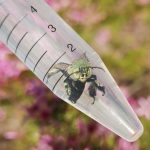
We collected specimens from at least 19 different bee species. Many of which have never been reported as far north as the NT, let alone Arnhem Land. Not a single European honey bee was seen! We’re now in the process of identifying all the plants that bees foraged on each month to see how their food sources change. By sequencing the DNA from the pollen on bees or in nests, we will then trace that DNA back to the plants in the region. This is particularly useful for identifying bee use of trees too tall to observe directly, such as the eucalypts that are (normally) bioindicators for guku season.
we repeat this research every dry season for a few more years, we will have enough data on bee populations, plant use and flowering patterns to understand what is happening to bees in North East Arnhem Land. We have already been invited to expand to a neighbouring homeland, where at least four ethnospecies of stingless bees are said to be present (fingers crossed we find Austroplebeia magna or Tetragonula mellipes!).
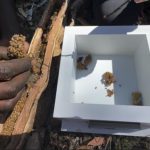
There is interest among Yolŋu in keeping stingless bees in hive boxes, rather than relying solely on wild harvesting. The miyalk (women rangers) are particularly interested in having a reliable source of propolis. Few Yolŋu have the means to access remote places like Barrkira due to a lack of transport, so almost everyone in Yirrkala is keen to keep hives closer to the community for guku. So we took a few different hive boxes to experiment with different species (thank you Trent from ABeeC hives). When guku was harvested, we demonstrated how to transfer the brood, workers, queen / queen cells and some food stores into hive boxes. These are now being cared for by Hamish Gondarra at Barrkira. Hamish is thrilled to have demonstration hives for visitors and is learning so much from his gifted copy of Tim Heard’s book.
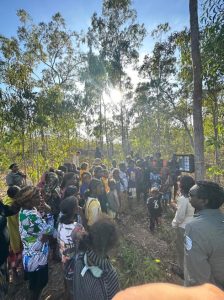
In the final month of our field season, we co-hosted a school camp through the Yirrkala School Learning on Coutry Program with Dhimurru and Yirralka Rangers at Barrkira. Like the name suggests, this involved taking groups of kids into the bush to learn, first-hand, the knowledge, skills and stories of their ancestors. Over 100 people travelled to Barrkira to participate, from as far west as the Tiwi Islands, across to Bremer Island and Yirrkala and south to Rorruwuy and Dhälinybuy. Many would not have made it if it weren’t for the grading of the dirt airstrip on the homeland, finished just days before the event.
Students (and adults) learned “two ways” about stingless and solitary bees: western science ways of investigating and Yolŋu understanding of connections, stories and hunting. Students learned about the process of pollination and plant reproduction, how to catch insects with aspirators and nets, how to distinguish between wasps, bees, flies, beetles and butterflies, how to collect data on insect visitors to plants, and how to find and harvest guku. Each activity saw Elders, teachers and rangers translating and incorporating traditional knowledge. It’s safe to say the guku and catching activities were the biggest hit. The kids were little snipers with their aspirators.
The transition back to urban life and lab work was confronting, particularly in the wake of the referendum, but it’s been good to have time to reflect on this opportunity and what it could mean going forward. The project has generated excitement and inspiration among youth for conservation, paid work for knowledge holders, living educational resources and, importantly, time “on country” for families that have dearly missed their homeland. For us as researchers, this is now more than just another project, it is a lifelong collaboration grounded in reciprocity and a shared love for bees and nature.
Keep following this research via @beescapes_au or @beesandblossoms.aus on Instagram
Cover photo: Some of the Barrkira research team: Josepha, Hamish (Yirralka Rangers), Clancy, Sean and Rachele
